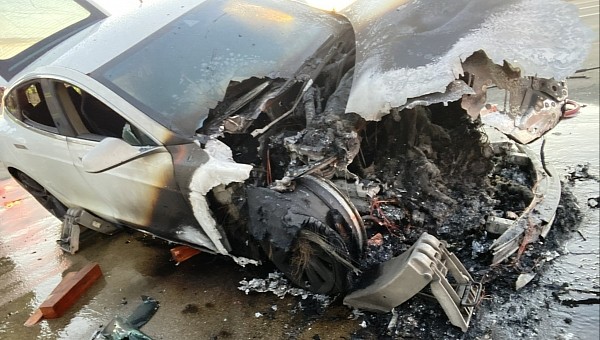A Tesla Model S caught fire on Saturday while driving on the highway in Sacramento. The firefighters rushed to the scene and used 6,000 gallons of water to put out the fire. Pictures shared by the Sacramento Metro Fire District show that the front of the car simply melted, despite the firefighting crews’ best efforts.
Electric vehicle fires are frightening, although statistics show us they are fewer than ICE fires. Nevertheless, they tend to have people respond emotionally to the news, especially when the car involved wears a Tesla badge. One of the reasons might be that EV fires are notoriously hard to extinguish. Because the high-voltage batteries generate their own oxygen during fires, there are only two ways to fight it: let it burn until there’s nothing left while protecting the surroundings, or cool down the battery to the point that the thermal runaway reaction subsides.
The Sacramento Metropolitan Fire District crews used a combination of the two to put out the fire on a Tesla Model S driving on a highway. According to the reports, the car’s battery compartment “spontaneously caught fire” while traveling at freeway speeds. Crews used jacks to access the car’s underside to cool down the battery. They needed around 6,000 gallons (22,700 liters) of water as the battery cells continued to combust. The pictures of the burnt Tesla show that the fire almost consumed the entire front part. Fortunately, no injuries were reported.
It’s not the first time an electric vehicle has caught fire, and those familiar with the Chevy Bolt EV saga know it too well. Tesla fire events are well documented, especially as the EV maker has more EVs on the roads than all other carmakers combined. The Sacramento fire department isn’t new to EV fires, having already responded to a battery fire last summer. In that case, the firefighters used a water pool to cool down the battery and stop it from reigniting.
Although the water pool is the preferred method to deal with an EV battery fire, especially in Europe and China, American firefighters are still learning on the job. The good news is that the Sacramento Fire District has developed a firefighting technique for EV fires. This includes the protective measures needed to ensure firefighters’ and other people’s safety. There is no mention of the water pool trick, though.
According to the instructions manual, Sacramento firefighters are instructed to use a thermal imaging camera to inspect hot spots on the battery. They are also warned about the toxic gases released during the fire, which include sulfuric acid. The funny thing is that the manual (see the gallery) specifically mentions the Tesla Model S as if this would be the only vehicle with a high-voltage battery that can ignite.
“After Model S has been involved in submersion, fire, or a collision that has compromised the high-voltage battery, always store the vehicle in an open area at least 50 ft (15 m) from any exposure,” reads the manual.
A recent Tesla Model S crash in Wakefield, Massachusetts, also resulted in a battery fire. In that case, the Massachusetts firefighters needed 20,000 gallons (75,710 liters) of water to put out the fire. Wakefield Fire Chief Tom Purcell admitted they lacked the training to deal with EV fires and had to call other jurisdictions for advice.
The Sacramento Metropolitan Fire District crews used a combination of the two to put out the fire on a Tesla Model S driving on a highway. According to the reports, the car’s battery compartment “spontaneously caught fire” while traveling at freeway speeds. Crews used jacks to access the car’s underside to cool down the battery. They needed around 6,000 gallons (22,700 liters) of water as the battery cells continued to combust. The pictures of the burnt Tesla show that the fire almost consumed the entire front part. Fortunately, no injuries were reported.
It’s not the first time an electric vehicle has caught fire, and those familiar with the Chevy Bolt EV saga know it too well. Tesla fire events are well documented, especially as the EV maker has more EVs on the roads than all other carmakers combined. The Sacramento fire department isn’t new to EV fires, having already responded to a battery fire last summer. In that case, the firefighters used a water pool to cool down the battery and stop it from reigniting.
Although the water pool is the preferred method to deal with an EV battery fire, especially in Europe and China, American firefighters are still learning on the job. The good news is that the Sacramento Fire District has developed a firefighting technique for EV fires. This includes the protective measures needed to ensure firefighters’ and other people’s safety. There is no mention of the water pool trick, though.
According to the instructions manual, Sacramento firefighters are instructed to use a thermal imaging camera to inspect hot spots on the battery. They are also warned about the toxic gases released during the fire, which include sulfuric acid. The funny thing is that the manual (see the gallery) specifically mentions the Tesla Model S as if this would be the only vehicle with a high-voltage battery that can ignite.
“After Model S has been involved in submersion, fire, or a collision that has compromised the high-voltage battery, always store the vehicle in an open area at least 50 ft (15 m) from any exposure,” reads the manual.
A recent Tesla Model S crash in Wakefield, Massachusetts, also resulted in a battery fire. In that case, the Massachusetts firefighters needed 20,000 gallons (75,710 liters) of water to put out the fire. Wakefield Fire Chief Tom Purcell admitted they lacked the training to deal with EV fires and had to call other jurisdictions for advice.
The vehicle battery compartment spontaneously caught fire while it was traveling freeway speeds on EB Hwy 50. The fire was extinguished with approx 6,000 gallons of water, as the battery cells continued to combust. Thankfully no injuries were reported. pic.twitter.com/PRmlWzQdXS
— Metro Fire of Sacramento (@metrofirepio) January 29, 2023






